 Fashions at Suppertime 1926
Fashions at Suppertime 1926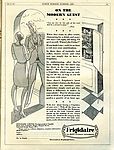 Refrigerator advertisement, Punch, May 26 1930
Refrigerator advertisement, Punch, May 26 1930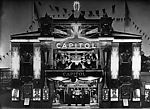 Capitol Cinema, London, 1937
Capitol Cinema, London, 1937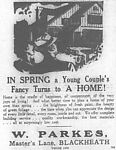 Advertisement from County Express, March 1837
Advertisement from County Express, March 1837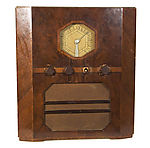 McMichael radio, 1930s, held at Black Country Living Museum
McMichael radio, 1930s, held at Black Country Living Museum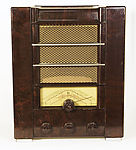 G.E.C. bakelite radio, 1936, held at Black Country Living Museum
G.E.C. bakelite radio, 1936, held at Black Country Living Museum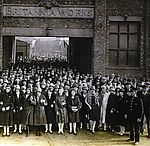 Workers at the Revo factory wearing the fashions of the day, 1920s
Workers at the Revo factory wearing the fashions of the day, 1920s

On one hand this was a period, which encompassed mass unemployment, dole queues, the Jarrow hunger marchers, the introduction of the means test, and a decline in standards of nutrition, health and welfare for many. On the other hand, it was a time when wages increased for the majority of people in employment; the 1930s saw the largest increase in the country’s housing of any other decade; car ownership increased to three million by 1939; consumer goods, such as radios, clothes, vacuum cleaners and washing machines, became more readily available and cheaper; chain stores such as Sainsbury's, Woolworths, Marks and Spencer and Littlewoods appeared on the high street.
In his book, “English Journey”, written in 1934, JB Priestley identified three different Englands. “ There was, first, Old England, the country of the cathedrals and minsters and manor houses and inns, of Parson and Squire; guidebook and quaint highways and byways England …
...Then, I decided, there is the nineteenth-century England, the Industrial England of coal, iron, steel, cotton, wool, railways; of thousands of rows of little houses all alike, sham Gothic churches, square-faced chapels, Town Halls, Mechanics’ Institutes, mills, foundries, warehouses, refined watering-places, Pier Pavillions, Family and Commercial Hotels, Literary and Philosophical Societies, back-to-back houses, detached villas with monkey trees, Grill Rooms, railway stations, slag-heaps and 'tips', dock roads, Refreshment Rooms, doss-houses, Unionist or Liberal Clubs, cindery waste ground, mill chimneys, fried fish shops, public houses … To the more fortunate people it was not a bad England at all, very solid and comfortable.
The third England I concluded was the new post-war England, belonging far more to the age itself than to this island. America, I supposed, was its real birthplace. This is the England of arterial by-pass roads, of filling stations and factories that look like exhibiting buildings, of giant cinemas and dance-halls and cafés, bungalows with tiny garages, cocktail bars, Woolworth's, motor-coaches, wireless, hiking, factory girls looking like actresses, greyhound racing and dirt tracks, swimming pools and everything given away for cigarette coupons.”
It is certainly true that people’s experience of living in Britain between the wars depended to a large extent on who they were, where they lived and what their occupation was.
Perhaps the most enduring image of the 1920s is that of the “Flapper”, a freedom-loving, social butterfly for whom life was a social whirl of endless parties.They horrified their elders and dazzled young men by wearing shockingly short and often backless dresses. They threw away their corsets and chopped off their hair, wearing it in the boyish "Eton Crop". They cultivated a flat-chested look with "flatteners", such as Symington Side Lacers, reinforced bust bodices, which when laced tightly at the side, flattened the bust. Hair was held in a bandeau or covered by a cloche hat. Flappers danced until dawn, taking great pleasure in outrageous dances like the Black Bottom and the Charleston. They lived in flats, drove their own cars and the most daring of them learned to fly. They were heard using the bad language that had become familiar during the war years. They frequented bars and public houses and smoked in public. (For a woman to smoke in a fashionable restaurant soon became acceptable, but it was regarded as very improper for her to do so when riding on a bus or on the street.) Cigarette smoking had increased greatly since WW1, especially among women. In Britain 80% of men and 40% of women smoked. Flappers were seen on motorbikes, riding on the pillions known as “flapper brackets”. All in all they were less submissive and more brazen than women were traditionally supposed to be.
From 1926 on, hair and skirts began to grow longer again, and after 1929 and the Depression that followed it, fashion changed quite sharply. Hemlines dropped almost overnight. By the end of the 1930s one distinctively "Thirties Look" had emerged: padded shoulders; tailored, slightly mannish suits; and hats that looked a little like men’s trilbies. Hair was longer again and generally pinned up on the head. This style was fixed by the years of the Second World War and did not change again until the post-war "New Look".
While the image of the “Flapper” was only true of wealthy women, the First World War had brought many changes to ordinary women’s lives. Single women, who had tended wounded men, risked their lives in munitions factories and worked in all weathers on the land, all without a chaperone, were not going to give up their newfound freedom easily. Women who had lived in hostels and shared flats during the war were not going to sit at home waiting for marriage to rescue them from the parental home. They had tasted independence, and social attitudes had become generally more relaxed. Young people now had far more opportunities to meet, un-chaperoned, in the workplace, at parties, and in the wide range of places such as dance halls, clubs or skating rinks where they spent their leisure time.
Many women, however, far from enjoying a fun-filled social whirl, faced an uncertain future. For large numbers of them the war had brought a great deal of heartache and financial uncertainty. Fashion and make-up, or even equal rights, were the furthest things from their minds. The statistic of almost one million men killed translated into fathers, brothers, husbands and sons lost in the war. The loss of a breadwinner affected all classes. Widows and those with husbands too badly injured to work struggled to keep their families. Because of the terrible loss of life there were, of course, many fewer men than women in their late twenties and thirties. There were many women born in the generation of the 1890s, who would never marry, and faced a future where they would have to support themselves, and in some cases their aging parents.
Although many women lost their jobs after the first world war, for example in transport, printing, munitions and engineering, more women than ever now worked outside the home, especially in secretarial and clerical work, in the retail trade, in textiles and in the newer light industries. Those who previously would have no choice but to go into domestic service could, and did, opt for better paid work, with brighter company, fixed hours and less need to be deferential to their employers. A factory worker or shorthand typist in Britain could earn £2 a week. Women from prosperous middle-class families were now expected to find an occupation of some kind before marriage. Educated women began to find the professions opening up to them, although many found they were discriminated against.
The problem of survival became more pressing as economic depression took hold of the country in the early 1930s. Women in the hardest hit areas of the North, industrial Scotland and South Wales, struggled to feed their families on the low level of unemployment benefit available. Men in heavy industries were the worst hit by unemployment, and while women in some areas were still able to find employment, they rarely earned a living wage. Skilled, unemployed men did not take kindly to the added humiliation of being forced to live on a wife’s meagre earnings.
After the First World War many of the formerly rich were forced to scale down their households. Higher taxes, higher wages for servants, and the difficulty of obtaining good servants at all, made it difficult to maintain large houses in both town and country.
This period, however, saw the building of more houses in Britain than in any other time. Four million flats and houses were built between 1918 and 1939, about half of them for sale, and most of the rest rented from local authorities. Estates of workers’ housing were constructed on a large scale, and improved public transport allowed people to live farther from their work, encouraging the growth of the suburbs. The authorities also resumed the practice begun before the war of creating garden suburbs and new towns, such as Welwyn Garden City, founded in 1920.
For those who could afford them, the houses advertised by private developers promised a new life as well as a new home. Leafy tree-lined streets promised quiet, genteel comfort away from the hustle and bustle of the towns and cities. Gardens were a feature of the new houses and gardening became a hobby.
The suburban housing boom and better wages enabled large numbers of the less well off to move up to a middle-class lifestyle. These new flats and houses had electricity, hot and cold running water, separate kitchens and bathrooms and indoor lavatories.
One of the features of middle-class family life was that individual family members could enjoy a degree of privacy in their own rooms, although there was a price to pay. The new homes were comfortable and easier to clean, but many women felt isolated and missed the extended families and support systems of their previously tight-knit communities.
Many people at the lower end of social scale, however, still lived in overcrowded, older housing stock. For many it meant back-to-back houses or tenement flats, with outside lavatories, often shared with others, no bathroom, cold water or no piped water at all. In Liverpool in 1932 a hundred families were still living in cellars. In Birmingham alone there were still 40,000 back-to-backs.
Family life was shaped to a great extent by the degree of wealth or lack of it, and by the housing available. Couples in the new urban society of the inter-war years were spending more time with each other and with their children. One reason for this was simply that, with shorter working hours, they had more leisure to do so. As far as working class people were concerned, there was another reason. The cramped conditions in which so many of the urban working class had lived in previous decades meant that the home was at best a place in which to eat and sleep. Better and more spacious accommodation in the 1920s and 1930s meant it could become a place in which to enjoy free time with the family.
Eating habits in Britain remained conservative. All but the very poor and the nutritionally conscious rich expected a substantial dish of meat, potatoes and vegetables at least once a day. Britain depended on large quantities of imported food, especially chilled or frozen meat from Argentina, Australia and New Zealand. In the early 1920s the British relied on home grown fruit, mainly apples, pears and plums, with oranges imported at Christmas time, but by the end of the inter-war years imported tropical fruits such as bananas and even mangoes were beginning to appear. Exotic vegetables such as peppers, courgettes or aubergines were still rarely seen, however.
There was a much greater understanding of nutrition and the importance of vitamins, proteins and minerals in the diet and of their connection with deficiency diseases. Despite the overall picture of improving health during the period, there were large numbers of people affected by unemployment, perhaps a tenth of the population, who suffered from malnutrition. From 1934, about half the children in British elementary schools were being provided with a third of a pint of milk a day. In 1939 health departments began to give cod liver oil and iron and vitamin supplements to mothers and small children who were clearly malnourished.
Stores such as Sainsbury's, Dewhurst butchers, WH Smith, Littlewoods and Marks and Spencer were beginning to appear on the high street. The American owned Woolworth's, whose British slogan was "nothing over sixpence" was a household name. People still did most of their shopping in open street markets or in specialist local shops, the butcher, the baker, the fishmonger and the grocer. Grocers would still weigh out some goods from bulk supplies kept in sacks behind the counter and wrap them in brown paper parcels, but many branded goods, including those familiar to us today, such as Heinz, Campbell's, Nestlé and Kellogg’s were becoming more readily available.
Convenience foods were becoming increasingly popular, and before the end of the 1930s virtually every kind of meat, fish, fruit and vegetable could be bought in cans and bottles, and the first frozen foods, marketed by Clarence Birdseye, were appearing on the shelves. Heavily processed white bread, potato crisps and instant coffee were also making an appearance.
The period between the wars was the first age of mass leisure and entertainment. Thanks to shorter working hours and increased spending power, ordinary people fortunate enough to be employed, had more time and more money to spend on fun. Women’s magazines came into their own in the interwar years, the most successful British one, “Woman” was selling three-quarters of a million copies by 1939. The introduction of the Penguin paperback book brought reading and self-improvement within the means of all but the poorest.
Eating out was, for most people, an occasional treat. The grand restaurants in Britain were well beyond the means of ordinary people, but the British now had Lyon’s Corner Houses, in which inexpensive meals were served in quite grand surroundings by ‘nippies’ , waitresses smartly attired in black dresses with white caps and aprons. Similar inexpensive restaurants could be found in cinemas and department stores. Moderately priced more exotic restaurants, Italian, Greek, Chinese or Indian for example, could be found near ports or in immigrant areas, but going to eat in such places was considered very adventurous. For special occasions and festivities, however, especially for Christmas, the family table at home was still the place to be.
From the mid 1920s on, the favourite evening entertainment for millions of families was listening to the radio (wireless). The wireless set, still a large piece of equipment until portables appeared in the late 1930s, dominated the living room. It offered, for the first time a medium for news and entertainment that whole families could share together. Radio broadcasting began in the early 1920s. Relatively expensive at first, the two and three valve sets dropped in price throughout the 1930s bringing them into the reach of all but the very poorest.
In Britain the old music hall barely survived the First World War and the advent of cinema. By 1930 there were 5000 cinemas in Britain. Many of the new cinemas were dramatic features of the new urban landscape, real picture palaces built in lavish ‘futurist’ or Babylonian styles, often seating three or even four thousand people. The new cinemas, with their soft seats, carpeting and bright, modernist décor, bars and tearooms, were much more comfortable than many people’s homes. Seats were cheap at 6d (2 ½p). Popcorn and ice-creams were sold and smoking was permitted throughout. Films were often viewed through a pall of smoke.
Cinemas were dream palaces where, especially in the 1930s, people could escape from the dreary realities of life to a world of excitement, glamour and romance. Hollywood believed audiences did not want films that reflected real life, but would welcome spending a few hours watching films about exotic places or the lives of the idle rich. Both daytime and evening performances provided a main and second feature, newsreels, cartoons and a short documentary or comedy feature. In addition to all this, there was usually a magnificent theatre organ, which would rise up to play during the intermissions.
Talkies appeared at the end of the 1920s and Technicolor was introduced in 1935. Hollywood was the film capital of the world. The first successful sound film was "The Jazz Singer", staring Al Johnson, which appeared in 1927.
The 1920s and 1930s were also the “dancing years”. In the 1920s, ragtime developed into jazz and young people flocked to dance halls and jazz clubs. People danced at home listening to the gramophone or the crystal radio, at afternoon tea dances, evening dance palaces and later at night clubs. The rich danced at hotels such as the Savoy in London, which introduced dancing during meals. Popular dances included the Charleston, the Shimmy and the Blackbottom. Many venues banned the Jitterbug dance, because some of the more spirited young women dancers revealed too much of themselves when doing it.
During the period more people were given paid holidays and more spent their holiday away from home. In Britain, by the late 1930s more than 20 million visitors a year were going to seaside resorts. Blackpool, whose famous "illuminations" became a permanent feature in 1925, had a resident population of 100,000 with seven million visitors a year by 1931. One Bank holiday in 1937 it had over half a million visitors, who arrived in 50,000 motor vehicles and 700 trains.
The inter-war years were also the age of the holiday camp, which originated in America, and offered "all-in" holidays based on individual chalets and communal dining rooms. In Britain, William Butlin opened the first commercial holiday camp at Skegness in 1936. There were 200 holiday camps in Britain by 1939, all offering accommodation, food and organised entertainment for as little as £2.00 to £3.00 a day.
The main development in transport between the wars was the huge growth in private automobile ownership. In 1921, one in 168 people owned a car. In 1930 there were just under a million licensed cars, roughly one for every 15 households. By 1939 the number had almost doubled. The 1920s and 1930s were the era of the luxury grand touring cars. Their prices put them far beyond the means of all but the very rich, but this was also the era of the cheap, mass produced car, pioneered by Henry Ford, with his Model T, soon nicknamed the ‘Tin Lizzie’. In 1924 the British Austin Seven cost £165. By 1932 it cost only £120. In the early 1930s the Morris Minor and the Ford Eight were on sale in Britain for £100. The increased number of cars on the roads led to the driving test being introduced in 1934, initially with a test fee of 7s 6d (37½p), later reduced to 5s (25p).
Rollover the captions in the box to see the available images in thumbnail format, click the caption to see the full-size image
| Reference: | 748 |
| Keywords: | |
| Archive Ref: | |
| Updated: | Thu 22 May 2008 - 1 |
| Interpretation written by | Barbara Harris |
| Author's organisation | |
| Organisation's website |